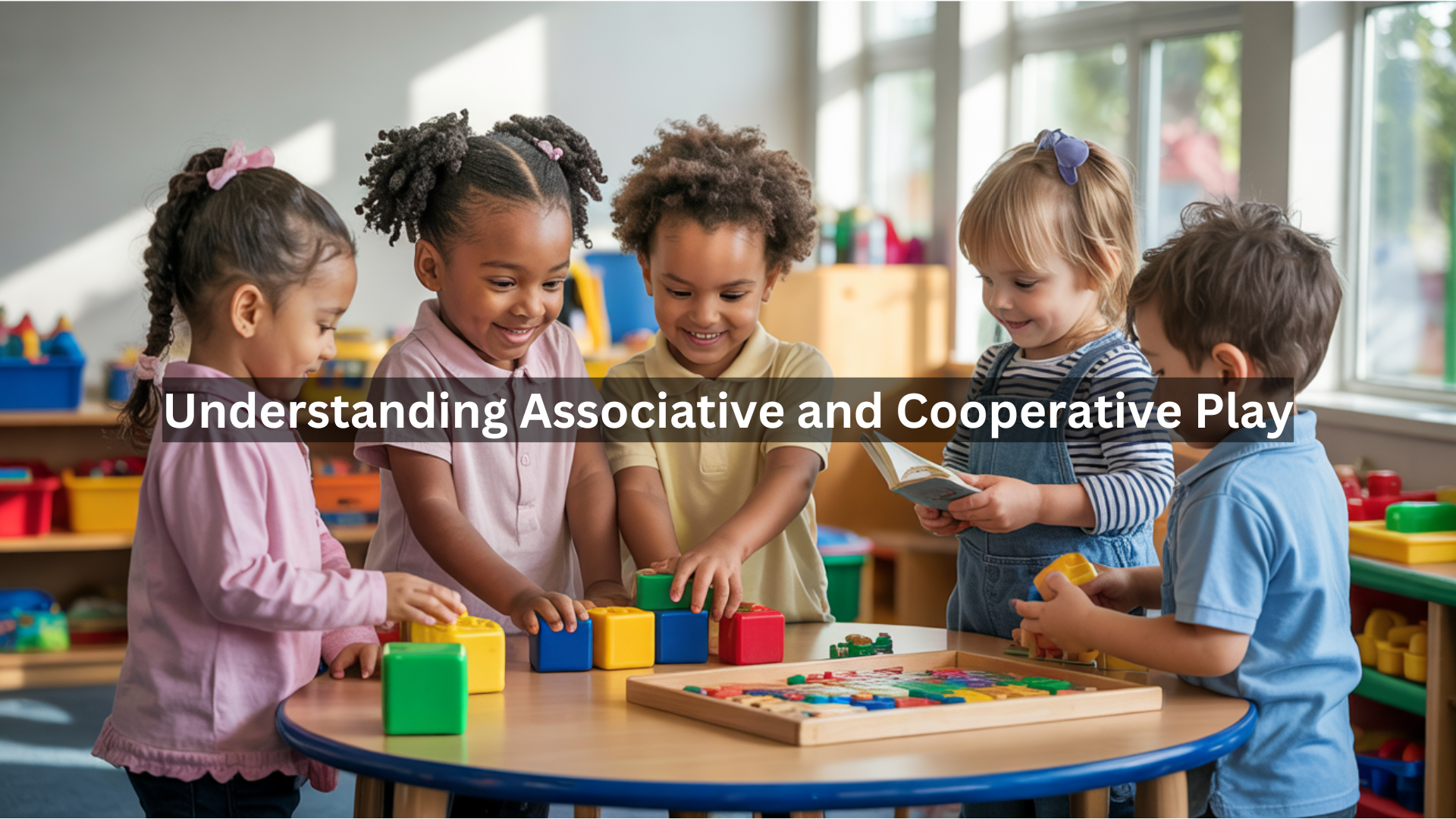
Have you noticed how children play differently at various ages? In this article, I’ll explain the crucial difference between associative play and cooperative play – two vital stages in your child’s social development.
As a parent and child development specialist for over 15 years, I understand your concerns about whether your child is developing normally. You’re not alone in wondering this.
I’ll help you:
- Identify which stage your child is in
- Understand what skills they’re building
- Learn how to support their development
By the end, you’ll know exactly what to look for and how to help your child thrive through these important stages. Whether you’re worried or just curious, this guide will give you clear answers about play development.
What Is Play in Child Development?
Play is how children learn about the world. It’s not just fun—it’s actually their main job! Through play, kids try new skills, test ideas, and figure out how things work. Play helps children grow in all areas—thinking skills, language, social abilities, and physical coordination.
I’ve noticed that as my children grow, how they play changes dramatically. What starts as simple exploring turns into complex games with others. Each type of play builds important life skills that help them become well-rounded people.
The Stages of Social Play
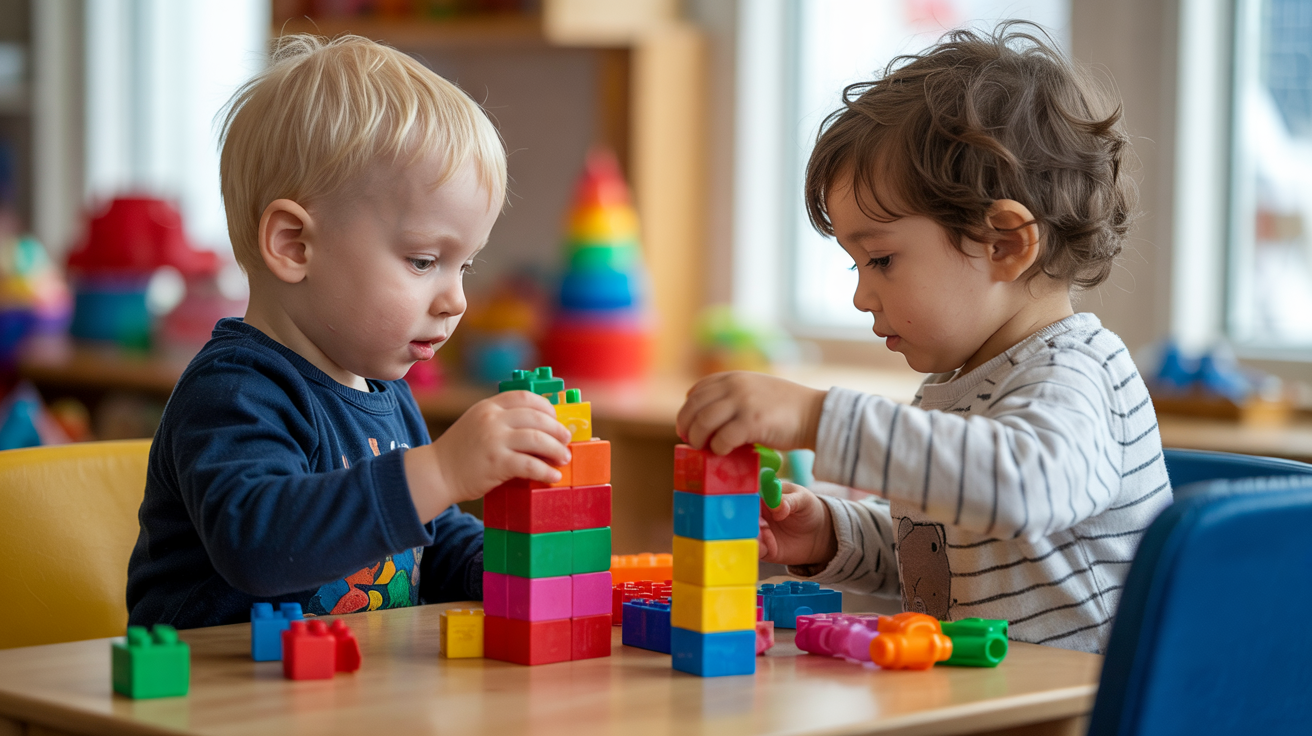
Play doesn’t simply appear in its fully developed form. Instead, it evolves through distinct stages as children grow. Each stage builds on the previous one, adding new social skills and complexity.
Social play develops in six main stages:
- Unoccupied Play (0-3 months): Random movements, exploring their bodies
- Solitary Play (0-2 years): Playing alone, focused on their activity
- Onlooker Play (2 years): Watching other children play without joining in
- Parallel Play (2-3 years): Playing next to, but not with, other children
- Associative Play (3-4 years): Playing together but with limited organization
- Cooperative Play (4+ years): Organized play with shared goals and rules
Today, I’ll focus on the final two stages—associative and cooperative play—since they mark the important shift to truly social play.
What is Associative Play?
Age Range for Associative Play

Associative play typically occurs between 3 and 4 years of age, though this can vary with each child. Some children may begin showing signs as early as 2½ years old, while others might develop these skills closer to 4 years.
What Associative Play Looks Like

In associative play, children play together and interact but without much organization or rules. They share toys and talk to each other, but each child still mainly follows their ideas.
There’s no clear goal or plan for the group. You’ll notice lots of conversation between children, frequent borrowing and lending of toys, and similar activities happening side by side.
Examples of Associative Play
- Children play with blocks in the same area, sometimes sharing pieces but building their structures.
- Kids playing with clay at the same table, showing each other what they made, and commenting on each other’s creations.
- A group digging in a sandbox, chatting and sometimes sharing tools, but each making their holes or castles.
- Several children finger-painting at the same table, using similar colors and occasionally adding to each other’s paper.
- Children in a dramatic play area all pretend to be animals, but each does their own thing rather than creating a coherent story.
Skills Developed Through Associative Play
- Taking turns and sharing materials
- Basic communication skills and expanded vocabulary
- Improved attention span and focus
- Growing social awareness and interest in peers
- Beginning to see others’ perspectives
- Decreased egocentrism
- Emotional expression and recognition
- Fine and gross motor skill coordination
What is Cooperative Play?
Age Range for Cooperative Play
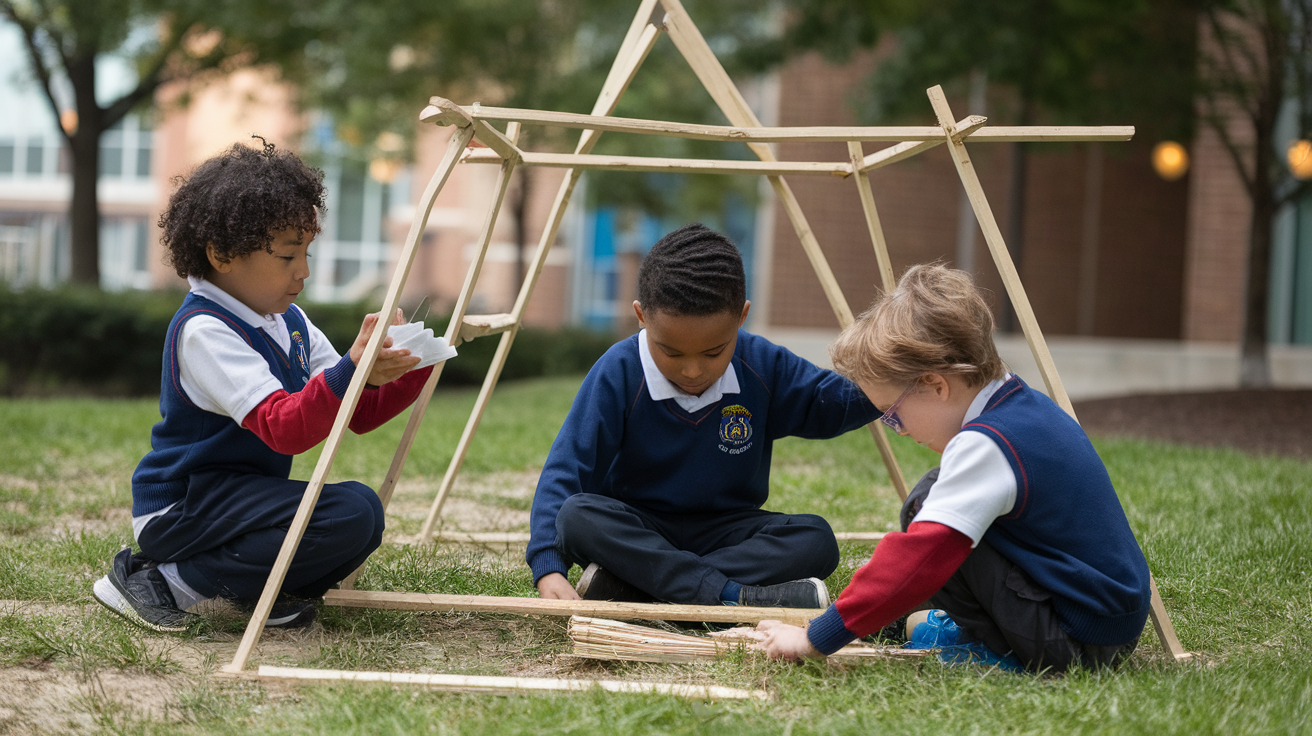
Cooperative play usually starts around age 4-5 and continues to develop throughout childhood. Most children show strong cooperative play skills by age 6, though complex versions continue growing into the teen years.
What Cooperative Play Looks Like
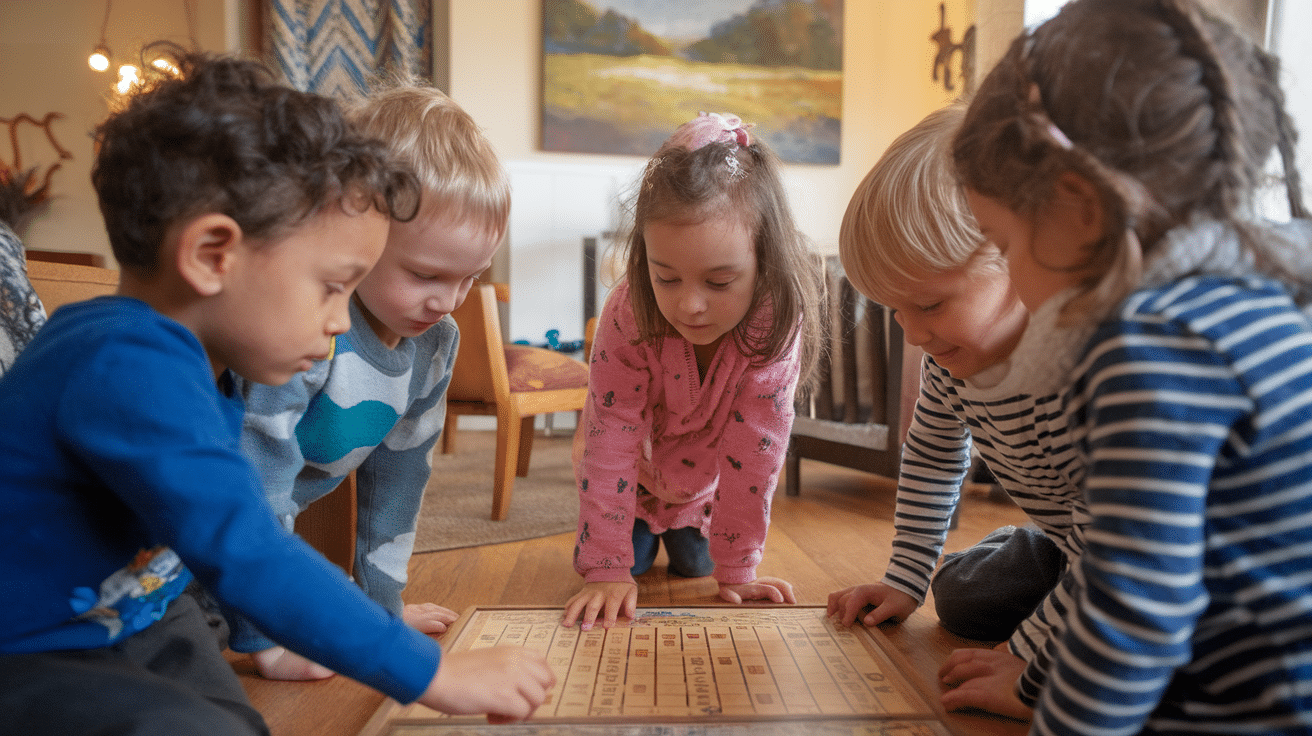
In cooperative play, children truly play together with a shared purpose. They set rules, assign roles, and work toward common goals.
This play is organized and may involve complex scenarios or games. You’ll observe children making plans together, dividing responsibilities, solving problems as a group, and creating more elaborate play scenarios that may last for extended periods.
Examples of Cooperative Play
- Playing house with defined roles (mom, dad, baby, pet) and a storyline they follow together
- Building a fort together where each child has a specific job (collecting materials, designing, constructing)
- Team sports where children follow rules and work together toward winning
- Putting on a play where each child has a part and they rehearse together
- Creating an elaborate block city where one child builds roads, another makes buildings, and a third adds vehicles
- Playing board games with rules everyone follows and taking turns in sequence
- Working together on a science project where tasks are divided but the goal is shared
Skills Developed Through Cooperative Play
- Leadership and following directions
- Group problem-solving and critical thinking
- Emotional regulation when things don’t go as planned
- Conflict resolution through negotiation
- Compromise and flexible thinking
- Planning and executing complex ideas
- Empathy and understanding others’ feelings
- Language and communication skills for complex ideas
- Delayed gratification
- Understanding fairness and rule-following
- Cultural and social norm comprehension
Associative vs Cooperative Play: Key Differences
While both stages involve children playing together, they represent distinct developmental milestones. Understanding these differences helps parents identify their child’s current stage and provide appropriate support.
The main differences between these stages are:
| Feature | Associative Play | Cooperative Play |
|---|---|---|
| Organization | Loose, minimal structure | Clear structure with plans |
| Goals | Individual goals | Shared group goals |
| Roles | No defined roles | Specific roles for each child |
| Rules | Few or no rules | Defined rules that all follow |
| Leadership | No clear leader | May have leaders and followers |
| Focus | On activity and materials | On the group process and outcome |
| Complexity | Simpler interactions | More complex social dynamics |
Why Does the Difference Matter?
As parents and caregivers, we often worry if our children are developing “normally.” Knowing the difference between these play stages can ease those concerns and help us provide better support. It transforms everyday observations into meaningful insights about our children’s development.
Understanding these stages helps me know what to expect from my children at different ages. When I see my 3-year-old playing near friends but still doing her own thing, I know she’s right on track with associative play.
These stages also show me how to support my children’s growth. A child who stays in solitary play much longer than expected might need extra help with social skills. Or, if my older child struggles with cooperative play, I can help him practice the skills he needs.
Each stage builds on the last, creating a foundation for more complex social skills. The shift from associative to cooperative play marks an important step toward teamwork, leadership, and social problem-solving—skills we use throughout life.
How Parents Can Support Both Stages?
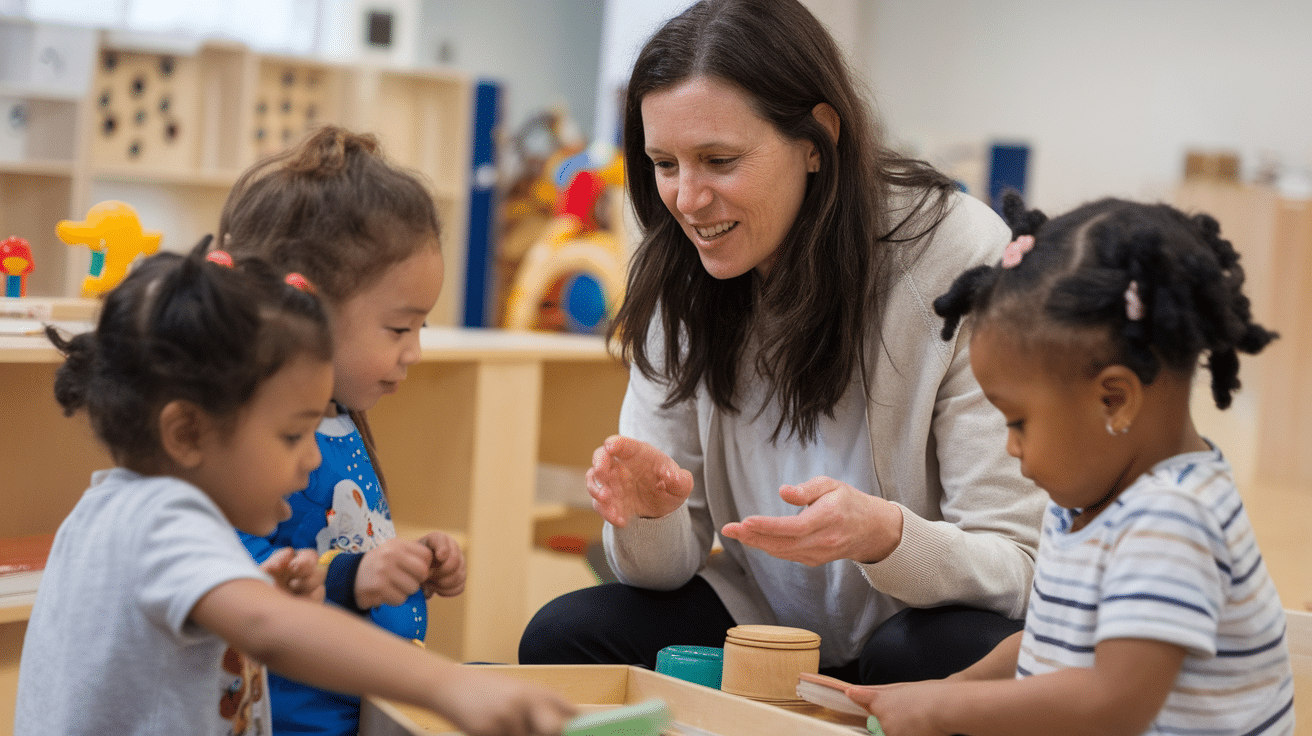
Children need different types of support as they move through play stages. The good news is that you don’t need expensive toys or specialized training – just thoughtful attention to what your child needs at each stage. Here are practical ways to encourage healthy development:
For Associative Play:
- Create play spaces where small groups can interact
- Provide plenty of similar materials (multiple crayons, blocks, etc.)
- Stay nearby to help with sharing conflicts
- Ask open-ended questions about what other children are making
- Point out when children have similar ideas
For Cooperative Play:
- Suggest simple group games with basic rules
- Help children work out conflicts without taking over
- Teach turn-taking and waiting
- Ask questions that help children plan together
- Praise good teamwork and problem-solving
- Model cooperative behavior in your activities
For Both Stages:
- Let children lead their play
- Give them time to work through problems
- Know when to step in and when to step back
- Arrange playdates with different children
- Recognize that all types of the game have value
Final Thoughts
When we watch children play, we’re witnessing important developmental work in action. Every shared toy, negotiated rule, and collaborative project represents a step toward becoming a socially capable person.
The progression from associative to cooperative play is a remarkable transformation that deserves our attention and support.
I’ve learned that play is much more than just fun—it’s how children prepare for life. As my kids move from playing side-by-side to truly working together, I see their social skills grow in amazing ways.
The shift from associative to cooperative play doesn’t happen overnight. It’s a gradual process that occurs as children develop more complex thinking and social skills.
By understanding these stages, I can better support my children’s growth and celebrate their progress.
What matters most is that children have plenty of chances to play in different ways. Whether they’re in the associative or cooperative stage, every play experience helps them learn about themselves and others.
Frequently Asked Questions (FAQs)
When Should My Child Move from Associative to Cooperative Play?
Most children begin cooperative play around age 4-5, but this varies. Some children might start earlier, while others take longer. What matters is progress, not exact timing.
My Child Prefers to Play Alone. Should I Worry?
Not necessarily. Many children still enjoy solitary play even after they’ve mastered cooperative skills. If your child can play cooperatively when they want to but sometimes chooses solo play, that’s perfectly fine.
How Can I Tell if My Child Is Struggling with Social Play?
Watch for frustration, frequent conflicts, or avoidance of group situations. If your child seems unable (rather than unwilling) to engage in age-appropriate play after many opportunities, talk with your pediatrician.
What Toys Best Support Cooperative Play?
Board games, building sets, dress-up clothes, play kitchens, and sports equipment all work well. The best “toy” is often just time with supportive adults and other children.
Is It Ok to Intervene in Children’s Play Conflicts?
Sometimes. Give children a chance to solve problems themselves, but step in if the situation becomes unsafe or extremely frustrating. Offer guidance by asking questions rather than imposing solutions.
